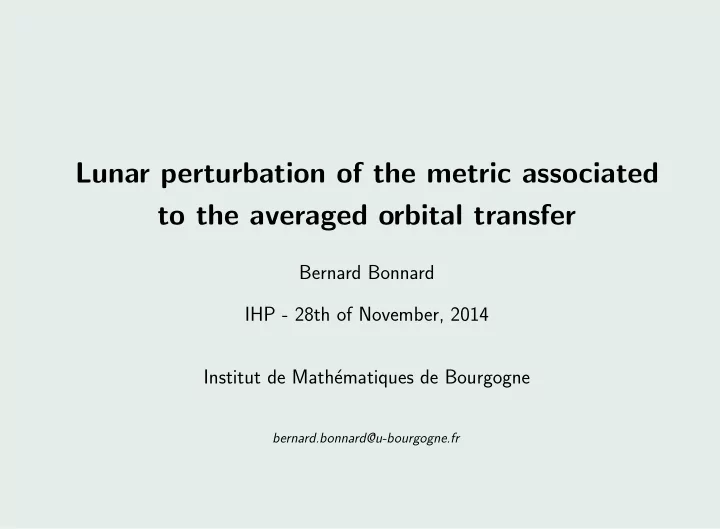

Lunar perturbation of the metric associated to the averaged orbital transfer Bernard Bonnard IHP - 28th of November, 2014 Institut de Math´ ematiques de Bourgogne bernard.bonnard@u-bourgogne.fr
Riemannian metric for the unperturbed problem x = ( n , ρ , θ ) are the slow orbital elements of Controlled Kepler equation the satellite. (planar case) n is the mean motion, 2 dx ρ the eccentricity, ∑ dt = u i F i ( x , l ) θ the argument of periapsis, i = 1 l is the fast angle pointing out the satellite’s dl dt = w 0 ( x , l )+ g ( x , l , u ) . position on his orbit. Averaged Hamiltonian for the energy cost � � ρ +( 5 − 4 ρ 2 ) p 2 H = 1 θ 18 n 2 p 2 n + 5 ( 1 − ρ 2 ) p 2 5 ρ 2 . 4 n 3 The Riemannian metric associated 5 5 g = 1 2 n 2 n dn 2 + 5 ( 1 − ρ 2 ) d ρ 2 + 3 3 5 − 4 ρ 2 d θ 2 . 1 9 n 3
Model for the lunar perturbation The perturbed dynamic can be written as 2 dx dt = F 0 ( x , l , l ′ )+ ∑ u i F i ( x , l ) i = 1 dl dt = � w 0 ( x , l )+ g ( x , l , u ) adding l ′ as a fast angle pointing out the dl ′ dt = w 1 ( l ′ ) satellite’s position on his orbit. The double averaged drift vector field corresponding to the lunar perturbation is � n ′ 2 1 − ρ 2 ∂ F 0 ( n , p , θ ) = 3 ∂θ ( n , p , θ ) . 4 n
Zermelo navigation problem A Zermelo navigation problem on a n-dimensional Riemannian manifold ( X , g ) is a time minimal problem associated to the system n dx ∑ dt = X 0 ( x )+ u i X i ( x ) i = 1 where F i form an orthonormal frame for the metric g and | u | ≤ 1 . The double averaged Zermelo Hamiltonian associated to our controlled system is � H perb = � p , F 0 ( x , p ) � + ε H ( x , p ) � � 3 � � � � n ′ 2 ρ +( 5 − 4 ρ 2 ) p 2 1 θ 1 − ρ 2 18 n 2 p 2 n + 5 ( 1 − ρ 2 ) p 2 = p θ + ε 5 ρ 2 . 4 n 4 n 3 .
Geometric concept of conjugate point Let − → H pert the Hamiltonian vector field associated to H pert . - z = ( x , p ) is a reference extremal, solution of − → H pert on [ 0 , t f ] . Jacobi equation δ z ( t ) = d − → ˙ H pert ( z ( t )) δ z ( t ) A Jacobi field is a non trivial solution δ z = ( δ x , δ p ) , vertical at time t if δ x ( t ) = 0 . - t c : the first conjugate time such that the map p 0 → exp x 0 ( t , p 0 ) = x ( t , x 0 , p 0 ) is not an immersion at t = t c . det ( δ x 1 ( t ) δ x 2 ( t ) ˙ x ( t )) - Rank test condition to com- 0.2 pute t c for a given trajectory x ( t , x 0 , p 0 ) 0.15 0.1 det [ δ x 1 ( t c ) ,..., δ x n − 1 ( t c ) , ˙ x ( t c )] = 0 . 0.05 0 −0.05 0 50 100 150 200 250 300 350 t
Time evolution of trajectories p n n final point final point −0.09 9 conjugate point conjugate point rad/day 8 −0.1 7 −0.11 6 −0.12 0 50 100 150 200 250 300 350 0 50 100 150 200 250 300 350 t (days) t (days) ψ p ρ 0.5 1.5 0 rad 1.45 −0.5 1.4 0 50 100 150 200 250 300 350 0 50 100 150 200 250 300 350 t (days) t (days) p θ θ 0.05 1.5 rad 1 0 0.5 −0.05 0 0 50 100 150 200 250 300 350 0 50 100 150 200 250 300 350 400 t (days) t (days) Evolution of the state vector Evolution of the adjoint vector ( n ( t ) , ψ ( t ) = π 2 − asin ( ρ ( t )) , θ ( t )) . ( p n ( t ) , p ρ ( t ) , p θ ( t )) . solide line : unperturbed case, dash-dot line : perturbed case.
Trajectories in ( θ , ψ ) coordinates ( θ , ψ ) ( θ , ψ ) pi/2 pi/2 conjuguate points conjuguate points ψ ψ pi/4 pi/4 0 pi/2 pi 3pi/2 2pi 0 pi/2 pi 3pi/2 2pi 5pi/2 θ θ Trajectories from the unperturbed case. Trajectories from the perturbed case.
Recommend
More recommend